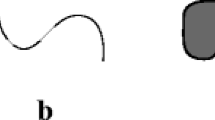Abstract
We present a data model for spatio-temporal databases. In this model spatio-temporal data is represented as a finite union of objects described by means of a spatial reference object, a temporal object and a geometric transformation function that determines the change or movement of the reference object in time.
We define a number of practically relevant classes of spatio-temporal objects, and give complete results concerning closure under Boolean set operators for these classes. Since only few classes are closed under all set operators, we suggest an extension of the model, which leads to better closure properties, and therefore increased practical applicability. We also discuss a normal form for this extended data model.
Similar content being viewed by others
References
S. Abiteboul, R. Hull and V. Vianu, Foundations of Databases (Addison-Wesley, 1995).
J. Bochnak, M. Coste and M.-F. Roy, Real Algebraic Geometry, Ergebenisse der Mathematik und ihrer Grenzgebiete 36, Folge 3 (Springer, 1998).
A. Brodsky, V. Segal, J. Chen and P. Exarkhopoulo, The CCUBE constraint object-oriented database system, Constraints, 2(3–4) (1997) 245–277.
M. Cai, D. Keshwani and P. Revesz, Parametric rectangles: A model for querying and animating spatiotemporal databases, in: Proceedings of the 7th International Conference on Extending Database Technology, Lecture Notes in Computer Science, Vol. 1777 (Springer, 2000) pp. 430–444.
J. Chomicki, Y. Liu and P. Revesz, Animating spatiotemporal constraint databases, in: Proceedings of the Workshop on Spatio-Temporal Database Management, Lecture Notes in Computer Science, Vol. 1262 (Springer, 1999) pp. 142–161.
J. Chomicki and P. Revesz, Constraint-based interoperability of spatiotemporal databases, Geoinformatica 3(3) (September 1999) 211–243. A preliminary report appeared in the Proceedings the 5th International Symposium on Large Spatial Databases (SSD'97).
M. Erwig, R.H. Güting, M.M. Schneider and M. Vazirgiannis, Spatio-temporal data types: An approach to modeling and querying moving objects in databases, Geoinformatica 3(3) (1999) 269–296. A preliminary report appeared in the Proceedings of the ACM Symposium on Geographic Information Systems (ACM GIS'98).
L. Forlizzi, R.H. Güting, E. Nardelli and M. Schneider, A data model and data structures for moving objects databases, in: Proceedings of the International Conference on Management of Data (SIGMOD' 00) (2000) pp. 319–330.
J. Goldfeather, S. Molnar, G. Turk and H. Fuchs, Near real-time csg rendering using tree normalization and geometric pruning, IEEE Computer Graphics and Applications 9(3) (1989) 20–28.
S. Grumbach, P. Rigaux and L. Segoufin, Spatio-temporal data handling with constraints, in: Proceedings of the 6th International Symposium on Advances in Geographic Information Systems (ACM GIS'98) (1998) pp. 106–111.
S. Grumbach, P. Rigaux and L. Segoufin, The DEDALE system for complex spatial queries, in: Proceedings of the International Conference on Management of Data (SIGMOD'98) (1998) pp. 213–224.
R.H. Güting, M.H. Böhlen, M. Erwig, C.S. Jensen, N.A. Lorentzos, M. Schneider and M. Vazirgiannis, A foundation for representing and querying moving objects, ACM Transactions on Database Systems 25(1) (2000) 1–42.
C.M. Hoffmann, Geometric and Solid Modeling: An Introduction (Morgan Kaufmann, 1989).
P.C. Kanellakis, G.M. Kuper and P. Revesz, Constraint query languages, Journal of Computer and System Science, 51(1) (1995) 26–52. A preliminary report appeared in the Proceedings 9th ACM Symposium on Principles of Database Systems (PODS'90).
G. Kuper, S. Ramaswamy, K. Shim and J. Su, A Constraint-based spatial extension to SQL, in: Proceedings of the ACM Symposium on Geographic Information Systems (ACM GIS'98) (1998).
G.M. Kuper, J. Paredaens and L. Libkin (eds.), Constraint Databases (Springer, 2000).
P. Revesz, Introduction to Constraint Databases (Springer, 2002).
P.Z. Revesz and Y. Li, MLPQ: A linear constraint database system with aggregate operators, in: Proceedings of the International Database Engineering and Applications Symposium (IDEAS'97) (IEEE Press, 1997) pp. 132–137.
P. Revesz and M. Cai, Efficient querying and animation of periodic spatio-temporal databases, Annals of Mathematics and Artificial Intelligence 36(4) (2002) 437–457.
M. Stonebraker and G. Kemnitz, The POSTGRES next-generation database management system, Communications of the ACM 34(10) (October 1991) 78–92.
A. Tansel, J. Clifford, S. Gadia, S. Jajodia, A. Segev and R.T. Snodgrass (eds.), Temporal Databases: Theory, Design, and Implementation, (Benjamin/Cummings, 1993).
L. van den Dries, Tame Topology and O-minimal Structures (Cambridge University Press, 1998).
M.F. Worboys, A unified model for spatial and temporal information, Computer Journal 37(1) (1994) 26–34.
M.F. Worboys, GIS: A Computing Perspective (Taylor & Francis, 1995).
G.T.J. Wuu and U. Dayal, A uniform model for temporal and versioned object-oriented databases, in: Temporal Databases: Theory, Design, and Implementation, eds. A. Tansel, J. Clifford, S. Gadia, S. Jajodia, A. Segev and R.T. Snodgrass (Benjamin/Cummings, 1993) pp. 230–247.
Author information
Authors and Affiliations
Rights and permissions
About this article
Cite this article
Chomicki, J., Haesevoets, S., Kuijpers, B. et al. Classes of Spatio-Temporal Objects and their Closure Properties. Annals of Mathematics and Artificial Intelligence 39, 431–461 (2003). https://doi.org/10.1023/A:1026086723558
Issue Date:
DOI: https://doi.org/10.1023/A:1026086723558




